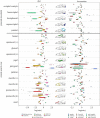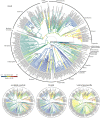Developmental origin underlies evolutionary rate variation across the placental skull
- PMID: 37183904
- PMCID: PMC10184245
- DOI: 10.1098/rstb.2022.0083
Developmental origin underlies evolutionary rate variation across the placental skull
Abstract
The placental skull has evolved into myriad forms, from longirostrine whales to globular primates, and with a diverse array of appendages from antlers to tusks. This disparity has recently been studied from the perspective of the whole skull, but the skull is composed of numerous elements that have distinct developmental origins and varied functions. Here, we assess the evolution of the skull's major skeletal elements, decomposed into 17 individual regions. Using a high-dimensional morphometric approach for a dataset of 322 living and extinct eutherians (placental mammals and their stem relatives), we quantify patterns of variation and estimate phylogenetic, allometric and ecological signal across the skull. We further compare rates of evolution across ecological categories and ordinal-level clades and reconstruct rates of evolution along lineages and through time to assess whether developmental origin or function discriminate the evolutionary trajectories of individual cranial elements. Our results demonstrate distinct macroevolutionary patterns across cranial elements that reflect the ecological adaptations of major clades. Elements derived from neural crest show the fastest rates of evolution, but ecological signal is equally pronounced in bones derived from neural crest and paraxial mesoderm, suggesting that developmental origin may influence evolutionary tempo, but not capacity for specialisation. This article is part of the theme issue 'The mammalian skull: development, structure and function'.
Keywords: cranial neural crest; development; ecology; morphometrics; skull evolution.
Conflict of interest statement
We declare we have no competing interests.
Figures






References
-
- Simpson GG. 1937. The beginning of the age of mammals. Biol. Rev. 12, 1-46. (10.1111/j.1469-185X.1937.tb01220.x) - DOI
-
- Grossnickle DM, Newham E. 2016. Therian mammals experience an ecomorphological radiation during the Late Cretaceous and selective extinction at the K–Pg boundary. Proc. R. Soc. B 283, 20160256. (10.1098/rspb.2016.0256) - DOI
Publication types
MeSH terms
LinkOut - more resources
Full Text Sources

